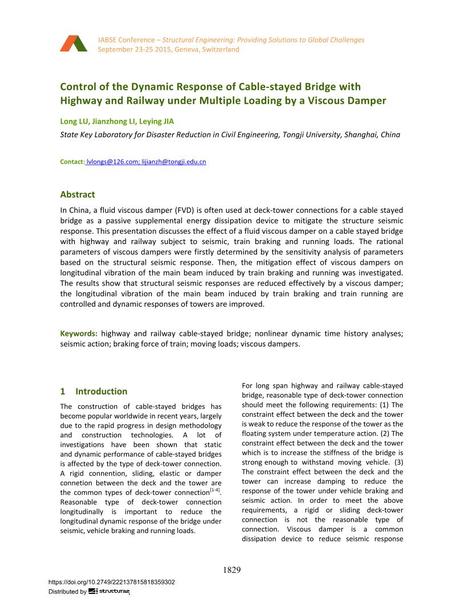Control of the Dynamic Response of Cable-stayed Bridge with Highway and Railway under Multiple Loading by a Viscous Damper

|
|
|||||||||||
Bibliographic Details
| Author(s): |
Long Lu
(State Key Laboratory for Disaster Reduction in Civil Engineering, Tongji University, Shanghai, China)
Jianzhong Li (State Key Laboratory for Disaster Reduction in Civil Engineering, Tongji University, Shanghai, China) Leying Jia (State Key Laboratory for Disaster Reduction in Civil Engineering, Tongji University, Shanghai, China) |
||||
|---|---|---|---|---|---|
| Medium: | conference paper | ||||
| Language(s): | English | ||||
| Conference: | IABSE Conference: Structural Engineering: Providing Solutions to Global Challenges, Geneva, Switzerland, September 2015 | ||||
| Published in: | IABSE Conference Geneva 2015 | ||||
|
|||||
| Page(s): | 1829-1836 | ||||
| Total no. of pages: | 8 | ||||
| Year: | 2015 | ||||
| DOI: | 10.2749/222137815818359302 | ||||
| Abstract: |
In China, a fluid viscous damper (FVD) is often used at deck-tower connections for a cable stayed bridge as a passive supplemental energy dissipation device to mitigate the structure seismic response. This presentation discusses the effect of a fluid viscous damper on a cable stayed bridge with highway and railway subject to seismic, train braking and running loads. The rational parameters of viscous dampers were firstly determined by the sensitivity analysis of parameters based on the structural seismic response. Then, the mitigation effect of viscous dampers on longitudinal vibration of the main beam induced by train braking and running was investigated. The results show that structural seismic responses are reduced effectively by a viscous damper; the longitudinal vibration of the main beam induced by train braking and train running are controlled and dynamic responses of towers are improved. |
||||
| Keywords: |
moving loads seismic action viscous dampers cable-stayed highway and railroad bridge non-linear dynamic time-history analyses braking force of train
|
||||


